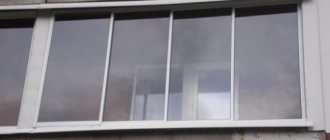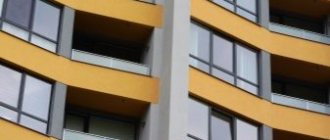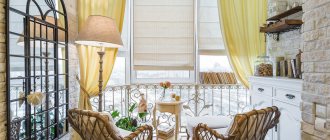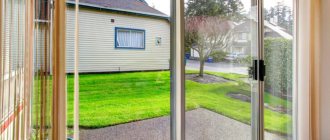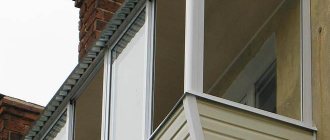Warm glazing is the arrangement of a balcony or loggia with translucent structures with high thermal insulation characteristics. For the manufacture of such structures, a special multi-chamber profile is used or, if we are talking about wooden blocks, laminated veneer lumber of sufficient cross-section. Filling is done with energy-saving double-glazed windows, usually double-chamber.
An example of prices for warm glazing of balconies in the Moscow company PVC Window Plant, link to their website.
We recommend this company based on positive reviews and competitive glazing prices.
| product - dimensions | Price |
| balcony - 3 meters | from 16,800 rub. |
| balcony - 6 meters | from 33,000 rub. |
| loggia - 2 meters | from 11,200 rub. |
| balcony door | from 6,800 rub. |
The installation of frames is carried out using “warm installation” technologies, all joints are sealed, and the thermal insulation of walls, floors, ceilings and other elements in contact with external cold areas is enhanced.
Complex measures transform the balcony into a living space suitable for full use at any time of the year.
No. 1. What is warm glazing?
First of all, we note that there is no technical term “warm glazing”, which means there cannot be any standardized values for it. But, despite this, this concept is widely used among the people and it means that when converting a balcony or loggia into a living space, it is necessary to achieve the same thermal insulation indicators that are accepted for the building envelope.
In order for the balcony to be as warm as in the apartment, it is necessary to insulate the floor, walls and ceiling of the balcony. Since a significant part of any balcony is occupied by translucent structures, they must be as airtight as possible and have high thermal insulation rates. All these measures are aimed at keeping the cold out of the room and not releasing accumulated heat. Where will the heat come from on the loggia or balcony? You can use electric heaters or electric heated floors. If there is no wall between the balcony and the adjacent room, heat will be easily transferred from the apartment.
Warm glazing may be needed in the following cases:
- when it is necessary to organize additional living space on the balcony, for example, an office, a recreation area, a workshop, a small gym, a greenhouse, etc.;
- when a balcony is combined with an adjacent room to increase its area. Living rooms, kitchens and bedrooms are often expanded in this way;
- when it is necessary to insulate a room adjacent to a balcony.
An alternative to warm glazing is the so-called. cold. It is made of lightweight structures that protect the balcony from rain, dust, gusts of wind, but are not able to become a barrier to cold and noise. In winter, a balcony with cold glazing cannot be used as a living space.
Accompanying services
Blinds and roller blinds for windows
From us you can also order the installation of blinds and roller blinds on a new balcony according to your dimensions. We have a large selection of materials in all colors. With the help of blinds/roller blinds you can easily close yourself off from your neighbors or get rid of excess light. We carry out installation quickly and efficiently.
Dryer Liana
The Liana dryer is an indispensable device for housewives and those who value their space. The dryer is installed on the ceiling, does not take up much space, and does not spoil the overall appearance of the interior. If you follow the operating rules, this model will last a very long time. The length of the dryer is selected taking into account your wishes and the area of the balcony.
Roto fittings
For those who value the impeccable work of every detail, we are ready to offer the installation of plastic windows on the balcony with Roto fittings. Roto Frank AG is a leading global manufacturer of fittings for plastic, wooden and aluminum windows and doors. In the window fittings market, Roto stands for innovative, customized and safe system solutions.
Window sill Danke
To implement the intended interior on the balcony, we are ready to offer a wide selection of Danke window sills. This brand is distinguished by its impeccable product execution, as well as a large color palette. The window sill will be installed on your balcony/loggia, strengthened, and will become an integral functional part of the new warm room in your apartment.
No. 2. Pros and cons of warm glazing of balconies
If it’s warm on the balcony even in winter, like in an apartment, then what disadvantages can we even talk about? Even warm glazing has disadvantages, but they are outweighed by its advantages. Let's start with them.
Advantages of warm glazing:
- increase in living space. Actually, for this reason, insulation of the balcony with the installation of sealed double-glazed windows is started. Thanks to glazing, the balcony becomes a full-fledged warm extension of the apartment, and everyone will figure out how to manage this area for themselves;
- improved sound insulation . Modern double-glazed windows used in warm glazing have excellent sound insulation properties, so it will be much quieter on the balcony and in the apartment;
- a sealed glazing system will become a reliable barrier to drafts, winds, dampness, and sunshine;
- after insulation and installation of glazing, the interior of the balcony can be decorated as desired , hang blinds or curtains - everything is the same as in an ordinary room;
- durability. Warm glazing systems last at least 30 years, if, of course, reliable materials were used. Before ordering, check with the manufacturer what profiles and double-glazed windows he uses - the lifespan of the entire structure depends on this. , for example, carries out glazing of balconies in Krasnodar and the region, using only high-quality profiles and double-glazed windows from well-known manufacturers; the company’s offers can be found on the page https://nem-okno.ru/balkony-i-lodzhii/. Confirmation of quality - a two-year guarantee for installation and a 40-year guarantee for the profile. Due to large production volumes, the company receives a decent discount from suppliers, which allows it to offer customers the best prices in the region.
Warm glazing also has disadvantages:
- high weight of the structure , since a multi-chamber profile and a double-glazed window with two or three glasses are used. Not every balcony can withstand such a load, so in some cases it will be necessary to reinforce the parapet and balcony slab. Very old and flimsy balconies may not be suitable for insulation and glazing at all. The condition must be assessed by a specialist who will make a verdict and, if necessary, recommend a set of preparatory measures;
- the massive design of warm glazing takes up a significant amount of usable space , but this sacrifice must be approached philosophically - nevertheless, due to such glazing we gain more space than we give up;
- a decrease in the amount of light , the same massiveness of the structure is to blame. In the room adjacent to the balcony or loggia, natural illumination will become noticeably lower;
- high cost due to the complexity of the system and installation nuances. Warm glazing costs more than cold glazing, and this is normal. Considering that you get additional living space, and the durability of the structure reaches decades, then the investment does not seem so serious. As a caution, we note that it is better not to settle for too cheap options. As a result, it turns out that either the final price will be higher than stated at once, or low-quality profiles and double-glazed windows from unknown manufacturers will be used, which are not able to retain heat and will soon need to be replaced.
As you can see, the disadvantages are not so significant compared to the advantages, but if you just want to enclose the area of your balcony and protect it from winds, precipitation and dirt, then choose lighter and cheaper cold glazing . There is an option with frameless glazing (or seamless glazing), which takes up minimal space, does not interfere with the passage of sunlight and looks very impressive.
Is it possible to insulate a balcony in winter? How to insulate a balcony for the winter?
Is it possible to insulate a balcony in winter? Insulate the balcony in winter or summer? How to insulate a balcony for the winter? What exactly is the difference between insulating a balcony in winter and in summer?
We will try to answer these and other questions as much as possible, analyzing each of them separately.
Is it possible to insulate a balcony in winter?
There is actually no difference in insulating a balcony in winter or summer, the same balcony, the same materials. stop ! . It’s already below zero outside the window, and it’s quite cool on the balcony itself.
The quality of balcony insulation in winter or summer depends on:
1. Masters who insulate the balcony.
The master is required to know all the nuances of balcony insulation, reliable, proven insulation technology, use of high-quality materials, and, most importantly, PERFORMANCE OF ALL WORK ON BALCONY INSULATION AT A HIGH LEVEL. The reasons why master finishers are not able to do their work efficiently:
The reasons why master finishers are not able to do their work efficiently:
They are doing this work for the first time (not a fact, if you try hard, everything can work out). They try, but due to inexperience they miss important points in insulating the balcony (there may be blowing, freezing, fungus formation). They work carelessly until the customer sees, they quickly attach the insulation, and quickly sew everything up with panels. The desire to do everything faster and get money. This is what “flyers” do when they move from one company to another (they are not responsible for their work, let the company sort it out later). This is usually done in the summer, when it is high season and there are not enough installers, companies recruit people from the street (rarely, but such “flyers” do come across). It is possible to check the insulation of the cylinder only in winter, then you will be able to determine the quality of the work performed.
2. Materials used to insulate the balcony.
Everything here is much simpler than it seems. In our set of materials in winter we use frost-resistant polyurethane foam from -20°C to +30°C. Otherwise, all materials are the same as in summer. The optimal temperature outside the window at which you can insulate a balcony is down to -15°C; on the balcony itself, the temperature will be significantly higher (this is if plastic PVC windows are installed on your balcony).
3. The technology used to insulate the balcony.
You can insulate a balcony with different materials and in different ways (you can easily find them on the Internet). It is possible to properly insulate a balcony only by using a certain technology. We use two insulation materials for balcony insulation: Penoplex (as the main insulation) and Penofol (thermal vapor barrier). Penoplex (expanded polystyrene) on the balcony prevents the penetration of cold from outside, warmth is felt immediately after installation on a cold wall. Penofol (foamed polyethylene with a reflective layer) is attached to Penoplex with a second layer, with foil inside the balcony. Reflects heat, saving it on the balcony. Penofol is used as a thermal vapor barrier for balconies. When using this technology, the balcony can be heated without any fear of heat loss. This method of insulating a balcony is known as the “Thermos Effect” (it keeps heat in winter, but the balcony heats up less in summer).
Balcony insulation in summer
Quality - we can only rely on the professionalism of the installers. Checking the insulation - it is impossible to check the quality of the insulation; it is not noticeable from the outside. Cost - prices increase during the season, you may have to wait in line.
Pros: Warm weather outside, maybe someone is on vacation and has time for repairs.
Insulating a balcony in winter
It’s cold, there are snowstorms outside the window.
Pros:
Quality - in winter, when there are fewer orders, companies no longer need to attract workers from the street. As a rule, only permanent teams remain - specialists in their field. Checking the insulation - it’s easy to check the work you paid for; the blowing will be noticeable.
No. 3. Warm glazing options
To organize warm glazing, systems with the following types of profiles are used:
- plastic (PVC) - the most popular, affordable and versatile option;
- a wooden profile is approximately the same in terms of heat and noise insulation as a plastic one, but is distinguished by its chic appearance and environmental friendliness, and you will have to pay extra for this;
- warm aluminum is used a little less often, although in some performance qualities it outperforms plastic and wood.
Differences may also lie in the characteristics of the glass unit and in the system for opening the sashes. In addition, you can make the system more functional using various kinds of accessories.
No. 4. Profile type for warm balcony glazing
Plastic profile
In most cases, a plastic profile is chosen for warm glazing. It is made of polyvinyl chloride (PVC) and reinforced with steel with a thickness of at least 1.4 mm so that the structure is strong enough. Inside the profile there are partitions that divide it into chambers: some of them are used for installing fittings, some are filled with reinforcing material, some remain hollow. The more cameras in a profile, the warmer, quieter and more reliable it will be. Choose a class A profile with an external wall thickness of at least 2.8 mm - only this can make the balcony truly warm.
Advantages of plastic profile:
- affordable cost, especially when compared with its wooden counterpart;
- excellent indicators of tightness, heat and sound insulation;
- resistance to temperature changes, winds, precipitation, so this profile can be used in any region;
- fire safety. The plastic profile is not a flammable material, but even if a fire occurs, its self-extinguishing properties will prevent the spread of fire;
- aesthetic appearance. The simplest white glossy profile looks quite good and fits well into most modern balconies, but if necessary, you can order a colored profile or make an imitation of any type of wood. Lamination occurs directly in production and does not in any way affect the performance of the profile. There are ways to do lamination yourself after installing the glazing;
- relatively simple installation;
- safety for humans - no toxic fumes;
- ease of care.
Minuses:
- the plastic profile intended for warm glazing has considerable weight, so in the case of weak balcony slabs such a solution may not be possible;
- non-repairability. If a scratch forms on the profile, it will be impossible to remove it;
- the increased electrostaticity of plastic contributes to the accumulation of dust on its surface, so cleaning will have to be carried out more often than in the case of other types of profiles
Wood profile
A wooden profile is often used when it is planned to combine a balcony or loggia with an adjacent room made in a certain style. For a classic interior, for example, a plastic profile is clearly not suitable. It will look out of place in country and eco styles. If wood plays a dominant role when decorating and furnishing a room, then it is better to opt for a wooden profile.
, larch, pine or oak are usually used . If previously solid wood was used, then a three-layer structure is used to make modern wooden profiles. The wood strips are positioned so that the fibers of adjacent layers are in different directions. The connection is made with environmentally friendly waterproof adhesives, so the end result is a system that is superior to solid wood in strength and rigidity and does not react so strongly to temperature changes.
pros:
- luxurious appearance of a wooden profile;
- environmental friendliness and naturalness;
- excellent performance in heat, sound insulation and tightness. According to research, with the same thickness, a wooden profile is warmer than a plastic one. The difference is minor, but still there;
- Scratches, impact marks, cracks and other damage can be easily disguised, and the external profile will remain as perfect as it was after installation.
Minuses:
- high price. Glazing with a wooden profile will cost the customer approximately 50-80% more than with a plastic profile;
- wood is a capricious material. The fact that the frame consists of laminated veneer lumber, which is treated with protective substances, makes it possible to increase resistance to negative natural influences, but if the treatment was carried out in violation of the technology, the frame may soon swell, and the glazing will have to be completely replaced;
- decent weight of the structure;
- fear of fire.
There are wooden frames that are equipped with an aluminum overlay on the outside; it reinforces the frame and protects the wood.
Warm aluminum
Aluminum profile is usually used to create cold glazing. Previously, such systems could only be installed in non-residential premises, but recently a warm aluminum profile has appeared. It consists of two aluminum chambers, between which a polyamide 1.5-4.5 cm thick is located. It plays the role of a heat insulator. During production, it is tightly connected to each of the profiles due to the presence of ridges. Aluminum profiles do not come into contact with each other, due to which thermal insulation is ensured. To make the profile even warmer, there may be several air chambers in the polyamide layer. The thermal break can be of different thicknesses, the choice depends on the climate, but for most regions of the country the minimum is 2.5 cm.
The advantages of this solution include:
- light weight. A warm aluminum profile loads the balcony much less than PVC or wood, so in some cases this is the only option for warm glazing;
- strength. The aluminum profile will withstand the weight of any double-glazed window and other loads associated with the operation of the glazing;
- good thermal and sound insulation performance, which approaches the characteristics of plastic windows;
- fire resistance;
- resistance to various types of negative weather influences: sun rays, precipitation, temperature changes will not destroy the profile;
- durability, which reaches 70-80 years;
- the plasticity of the metal and polymer insert allows you to make windows of almost any shape, so if you have a bold design solution in mind, then using an aluminum profile it can be realized;
- safety;
- ease of maintenance and maintainability;
- aesthetics. Not so long ago, this point would have raised eyebrows, because aluminum frames were boring, monotonous and clearly not suitable for living space. Now manufacturers have learned to coat the profile with powder paint, use anodizing, install decorative overlays, for example, made of wood, and ultimately get a pretty nice system.
minus :
- high price but, in essence, we are paying for higher durability and other advantages.
No. 5. Characteristics of double-glazed windows
Although the profile is an important part of the glazing, the largest part is occupied by the glass unit, so its choice should be treated with even greater care. A modern double-glazed window consists of several glasses, which are united by a spacer frame. Thermal and sound insulation indicators depend on the number and type of glass, the type of filling of the chambers, the distance between the glasses and other parameters.
Practice shows that in most cases, double-chamber conventional or single-chamber energy-saving double-glazed windows are suitable for balconies. To ensure that the window company does not deceive you and impose unnecessary things on you, you need to be aware of the issue of the range of double-glazed windows:
- the main parameter is the number of cameras. Not to be confused with cameras in a plastic profile! If there are two glasses, then one chamber is formed between them, if there are three, two chambers, etc. Air is an excellent heat insulator, and the more air chambers, the better the double-glazed window retains heat. The heat transfer resistance of a single-chamber double-glazed window is 0.3 m2K/W, a double-chamber one is 0.5 m2K/W, and a three-chamber one is 0.7 m2K/W. However, the more cameras, the heavier the structure, and we are dealing with a balcony that cannot be overloaded. Therefore, the maximum in most cases is a double-glazed window. You can also take single-chamber with low-emissivity glass – its thermal insulation properties are the same as a two-chamber one, it weighs less, but costs more;
- type of glass. The simplest option is the usual float glass 4-6 mm thick, with the thicker version intended for installation in noisy areas. Eat glass with special coating, which reflects heat rays. It turns out that in summer such a double-glazed window reflects the sun's rays, preventing overheating, and in winter it does not allow heat to escape from the apartment. Only one piece of glass in a double-glazed window is low-emissive. Thanks to this technology The heat transfer resistance of a single-chamber double-glazed window can be increased to 0.56 m2K/W. Just what you need for your balcony! When it comes to warm glazing, thermal insulation properties come first, but do not forget that other problems can be solved with the help of a properly selected double-glazed window. For example, for noisy areas they are intended noise-proof double glazed windows (produced on the basis of triplex glass and special film), for southern balconies - solar control double glazed windows, which reflect part of the rays. There is also impact-resistant and fire-resistant double-glazed windows, and the top of progress is stain-resistant double-glazed windows, as well as heated double-glazed windows;
- distance between glasses. The smaller it is, the more compact the glazing will be, and this is beneficial for us - the balcony is not rubber. On the other hand, the larger the air chambers, the better the soundproofing qualities of the double-glazed window. If the balcony faces a busy street, it is better to take a double-glazed window with different chamber thicknesses. Glass of different thicknesses works well in terms of sound insulation - all of these are noise barriers;
- glass chambers can be filled air, but the structure will be much warmer if argon is used. This is what is used in low-emissivity i-glasses.
Double-glazed windows are often designated by formulas like 6M1-10-4M1-8Ar-4I, which means that you have a double-chamber double-glazed window with different glass thicknesses (6, 4 and 4 mm), one of the glasses is low-emission, one chamber is filled with argon. Before choosing, evaluate the climate of the region, your own requirements, the characteristics of the area, as well as the heat transfer resistance of different structures, and only then place an order.
The next stage is the choice of insulation
To make a warm balcony, glazing alone will not be enough. It is also necessary to insulate the floor, roof, facade and side walls. You must remember that the material used must be of high quality:
- it should not be exposed to wetness,
- burning
- other types of destruction.
insulating the ceiling with polystyrene foam
The most suitable option would be to choose materials based on polystyrene foam and its components. The advantages of these substances are low cost, low weight and relatively small thickness. There are also disadvantages, which include their fragility and fragility. You can make your thermal insulation more reliable by using mineral wool, such as ISOVER or URSA. Most specialists offer foil lining for water vapor barrier. This material is a porous polyethylene, which is covered on top with a Mylar film interspersed with metal. This substance does not collect moisture, easily reflects ultraviolet rays and prevents condensation.
Rule
The thickness of one of the insulation layers is usually 50-150 mm. This figure is selected individually, in accordance with climatic conditions, which are reflected in the tables of SNiP 23-02-2003, SNiP 23-01-99 and SP 23-101-2004.
waterproofing
However, we can highlight the main requirements for materials for insulation. To begin with, such materials must be light in weight. This is important, since heavy weight can lead to overloading of the floors. In addition, it must have a fairly low thermal conductivity, which will vary the thickness of the layers. You also need to remember that sealing various kinds of gaps and seams that appear during glazing is extremely important. Such cracks must be sealed using specialized foam or other sealing materials.
Various heating methods
Everyone knows that winters in Russia are quite harsh and, therefore, additional heating of the balcony should be done. However, you must remember that central heating cannot be installed there under any circumstances according to existing building codes. Don't panic, there are two ways out of this situation.
- The first of them is the installation of heated floors. Specialized electrical elements are attached to a concrete base, which is covered with a cement-sand screed. This will help distribute the heat evenly over the entire surface and warm the air under the floor. A warm floor will reliably save you from frost in winter.
- An alternative to the above method would be to install an electric fireplace or other heating devices such as a radiator or air heater. Taking into account the possible small area, it is better to use oil radiators from the ERMB, ERMS series. Keep an eye on the electrical power, as it should not exceed 1.5-2 kW. The downside here is that the cost of consumed electricity will increase significantly.
No. 6. Opening type
Warm glazing cannot be frameless, i.e. it will consist of several doors. As a rule, some of these sashes remain blind - this design is cheaper. Several doors must be opening, otherwise there will simply be a greenhouse on the balcony. The opening mechanism may be different:
- a rotating sash is the simplest option, allowing you to fully open the sash, letting in as much air as possible. In addition, the sash can be washed on both sides, and you can even reach the adjacent blinds to put them in order. The downside is that it is impossible to open the window just slightly for ventilation, but for this purpose you can use special combs that allow you to fix the sash at a certain angle;
- The flap is fixed and can be tilted to a certain angle into the room. It can be used to ventilate, but in terms of glass care this design is quite complicated;
- the tilt-and-turn design is more expensive, but at the same time it is as functional as possible;
- A transom is something like the good old vents; only the upper part of the sash is folded back, the lower part remains blank.
Sliding windows and warm glazing are incompatible things.
No. 7. Accessories for balcony glazing
A properly selected glazing system will not only be warm, but also maximally functional. The structure can be equipped with the following accessories:
- ventilation valve can be installed on the top of one of the doors, allowing for fresh air flow, but protecting the apartment from drafts, dust and noise;
- mosquito net mandatory for those doors that will open, otherwise you can go crazy fighting off hordes of mosquitoes, flies and other insects;
- handles with lock and children's restraints will become an obstacle for a curious baby. He will be able to admire the view from the window, but tragic consequences will be avoided;
- comb limiter has already been mentioned. If you decide to save money and take a sash with only one swinging mechanism, then it is better to immediately order a comb;
- if the balcony is located on the first or last floor, in a crime-ridden area, it is better to take care of the installation in advance anti-burglary fittings. This is a whole system aimed at protecting the balcony from any actions of intruders - hacking, use of brute force, etc.
External insulation
The nature of external insulation is selected depending on the time of year.
If the outside temperature is above zero, then you can use polystyrene foam followed by finishing with plaster. First, the surfaces are cleaned of dirt. Sheets of polystyrene foam or expanded polystyrene are glued onto them. Additionally, they are reinforced with special dowels. A reinforcing mesh is pulled onto the surface. It is additionally secured using an adhesive composition. Apply it in two layers. After hardening, uneven surfaces are removed and finishing is performed.
Rice. 3 External thermal insulation and finishing
Insulation with mineral wool can be carried out at any time of the year. The sheathing is attached to the surface of the balcony. Mineral wool slabs are laid between its elements. The material is covered with waterproofing from above, which is secured with smaller wooden blocks. Finally, the balcony is finished with siding or other similar materials.

